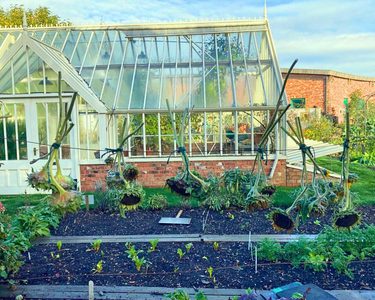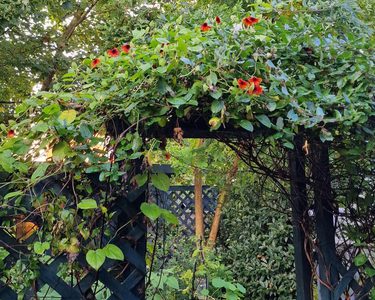Five ways to feed garden birds for free

Providing plentiful all-year-round food and water for garden birds can help support them with breeding, moulting, staying hydrated in summer and replenishing after migration – but it’s particularly important during winter when food sources are scarce.
Bird food buying can have a footprint, however. A lot of commercially produced birdseed is packaged in plastic, and peanuts and nyger seed can be transported long distances to get to your feeder. So it’s worth being picky about what you buy, and looking out for organic seeds, which won’t have been sprayed with pesticides.
Better still, choose natural, low-cost ways to feed them this winter. You could even have a go at our homemade kebab bird feeder at the bottom of this blog!
1. Leave flowerheads such as teasels, cone flowers, globe thistles and sunflowers as a banquet of seeds, and overwintering insects. We like to pop up a sunflower washing line in our organic demonstration garden (pictured above)!
2. Berry-rich trees such as rowan, hawthorn and holly are particular nutrient-rich for birds, but you could also consider planting a nut tree such as hazel for nuthatches. (If squirrels steal all the nuts, Turkish hazel can be a good alternative as it has extra prickly cases, which are less attractive to them!) Windfall apples and pears are also favoured by thrushes and blackbirds, and they don’t mind if the fruit is bruised or battered.
3. Climbers and shrubs such as hip-laden roses and berry-rich ivy and honeysuckle are attractive to birds both for their fruits, but also the insects that like to use these plants as a shelter. Homegrown bird food is healthier and cleaner overall, reducing the need for feeders and tables which can harbour diseases if not cleaned regularly.
4. A diverse lawn, particularly one with patches of longer grass, will attract blackbirds, goldfinches and house sparrows. They will forage for seeds and insects, and the more diverse your planting is, i.e. encouraging dandelions and clover, the more visitors you’ll get.
5. Household scraps and leftovers can be added to bird tables in small quantities as long as they don’t contain salt. Try soft fruits, uncooked porridge oats, cooked rice and plain pasta, boiled or mashed potatoes, mild cheeses, uncooked, unsalted bacon rind and raisins and sultanas. You could combine things like dried fruit, oatmeal, sunflower seeds and cheese into homemade fat balls using lard or suet.
Look out for our Best Berries for Birds feature in our autumn/winter edition of Organic Way members’ magazine. If you’re not a member, you can join here to get a copy.

Make your own kebab bird feeder!
You don't need to buy expensive, plastic bird feeders to feed feathered friends in your garden. Try this easy homemade craft...
You will need:
- Kebab stick
- Metal skewer
- Sticks and twigs
- String
- Apple (quartered)
- Fat balls
- Pine cones
Method:
1. Fat balls can be made by melting lard in a pan (mixed seeds are optional), and moulding with ice-cream scoops. Sandwich the halves together and firm in the freezer. Alternatively, you could use blocks of mild, unsalted cheddar.
2. Make a hole in the centre of your apple quarters, fat balls and pine cones using the metal skewer.
2. Thread alternating pieces on to the kebab stick, tying twigs at various intervals to make perches.
3. Once complete, tie a piece of string to the top of the kebab stick and push a pine cone on top to secure. Hang up in your garden and wait for the birds to enjoy!
